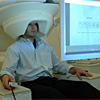Session Overview

|
Understanding how the brain makes the mind takes an array of research methods. In this session, you’ll learn the key principles, strengths, and limitations of brain injury studies, neural stimulation, and various recording techniques. The lecture video ends with a look at how research methods can help answer big questions about higher-level cognition, such as:
Keywords: lesion, neural stimulation, TMS, recording, structure vs. function, CT, DTI, EEG, MEG, PET, fMRI A patient in a MEG scanner. (Public domain image from National Institute of Mental Health.) |
Session Activities
Readings
Read the following before watching the lecture video.
- Finish the chapter you started for the previous session:
- [K&R] Chapter 2, “The Biology of Mind and Behavior: The Brain in Action”
- [[Stangor]](/courses/9-00sc-introduction-to-psychology-fall-2011/pages/syllabus#Stangor) Chapter 3 “Brains, Bodies, and Behavior”
Lecture Videos
View Full Video
View by Chapter
- Methods of Studying the Human Brain
- Lesion (Injury) and Stimulation Studies
- Recording Studies of Structure: CT, MR, DTI
- Recording Studies of Function: Electrical (EEG, MEG) & Metabolic (PET, fMRI)
- Sample Studies: Social Cognition (Empathy) & Vegetative States
Video Resources
- Higher resolution version of animation played during lecture: cortical brain growth, ages 4 to 21, top view (MOV). From Gogtay, N., et al. “Dynamic Mapping of Human Cortical Development During Childhood Through Early Adulthood.” PNAS 101, no. 21 (2004): 8174-9.
- Lecture Slides (PDF - 4.5MB)
Discussion: Brain
The brain: let’s talk about its major systems, how we study them, and how they make the mind. This is just really cool to think about the fact that there’s this organ that sits in your cranium, that sits between your two ears… Read more »
Check Yourself
Name four ways that scientists can study the brain. Describe each of these methods. Provide a description of a study or experiment that used one of these methods.
› Sample Answer
Here are four methods, selected from the eight methods discussed in the lecture video.
Lesion or patient behavioral studies. After someone has surgery to remove part of the patients brain there may be a lesion in a particular location. Lesions may also occur after head injury or other trauma, such as a stroke. Lesions prevent function in a particular brain region. Psychologists can study the differences in behavior and cognition between people with lesions and normal people. By analyzing these differences psychologists can infer that the part of the brain with the lesion is involved in a particular behavior or cognitive process.
Electroencephalography (EEG) measures the electrical activity on the scalp of a person. This electrical activity is produced by the activity of neurons. This allows researchers to observe rapid changes in electrical activity that is associated with a particular cognitive process.
Functional magnetic resonance imaging (fMRI) uses a large magnetic field to measure differences in blood flow across the brain. Changes in blood flow are believed to be associated with changes in neural activity. Scientists can study the changes in blood flow that are associated with particular cognitive processes.
Transcranial magnetic stimulation (TMS) deliver magnetic pulses to the brain to deactivate a particular brain region. By deactivating a particular brain region scientists can study the effects of loss of activity in that region on particular cognitive processes.
Example study using one of these methods: Phineas Gage had an iron rod go through his skull and into his orbitofrontal cortex. Afterwards he retained his intelligence, but his behavior was dramatically different. He became, irritable, rude, irresponsible and dishonest. Scientists could conclude that this area of the brain is necessary for appropriate social behavior, emotion, and morality. This is an example of a lesion-based study. Anther example is studies of split brain patients.
Further Study
These optional resources are provided for students that wish to explore this topic more fully.
| TYPE | CONTENT | CONTEXT |
|---|---|---|
| Video | “Jill Bolte Taylor’s stroke of insight.” February. 2008. TED Talks. Accessed August. 19, 2011. [00:18:42] | A neuroscientist describes her experience having a massive stroke and subsequent recovery |
| Web resource | Johnson, K. A., and J. A. Becker. The Whole Brain Atlas. | Includes a detailed primer on neuroimaging and a library of brain images |
| Video | NIMHgov. “The Brain’s Inner Workings Part II: Cognition.” Aug. 12, 2009. YouTube. Accessed Feb. 14, 2012. http://www.youtube.com/watch?v=PKj9i1qS08M | Short video on imaging techniques that illustrate the neurological basis of higher brain function |
| Textbook supplement | Study materials for Chapter 3, “The Biology of Mind and Behavior,” in Study Site for Psychology in Context, 3/e (Pearson Education, 2007) | Practice test questions, flashcards, and media for a related textbook by Kosslyn & Rosenberg |








